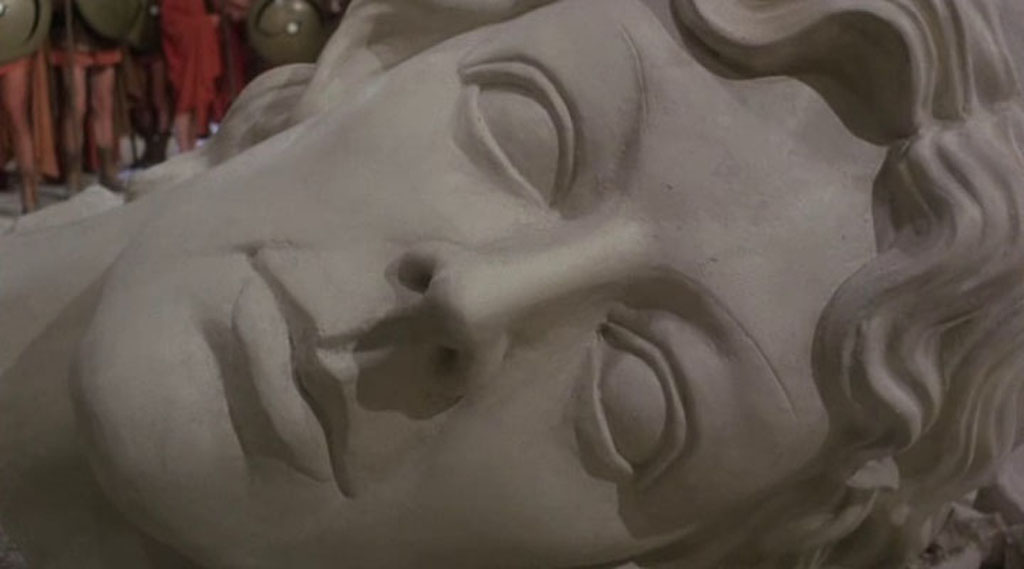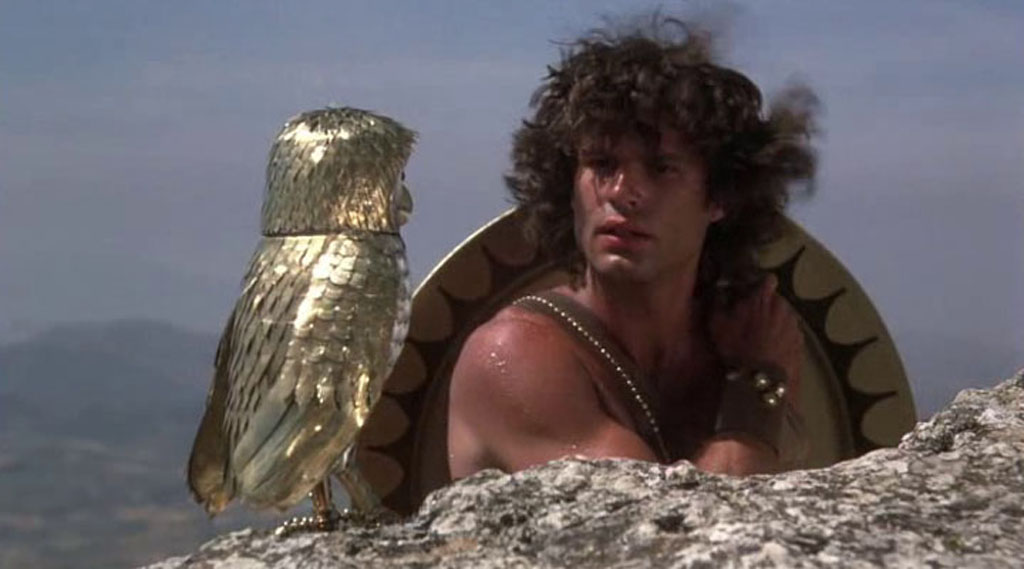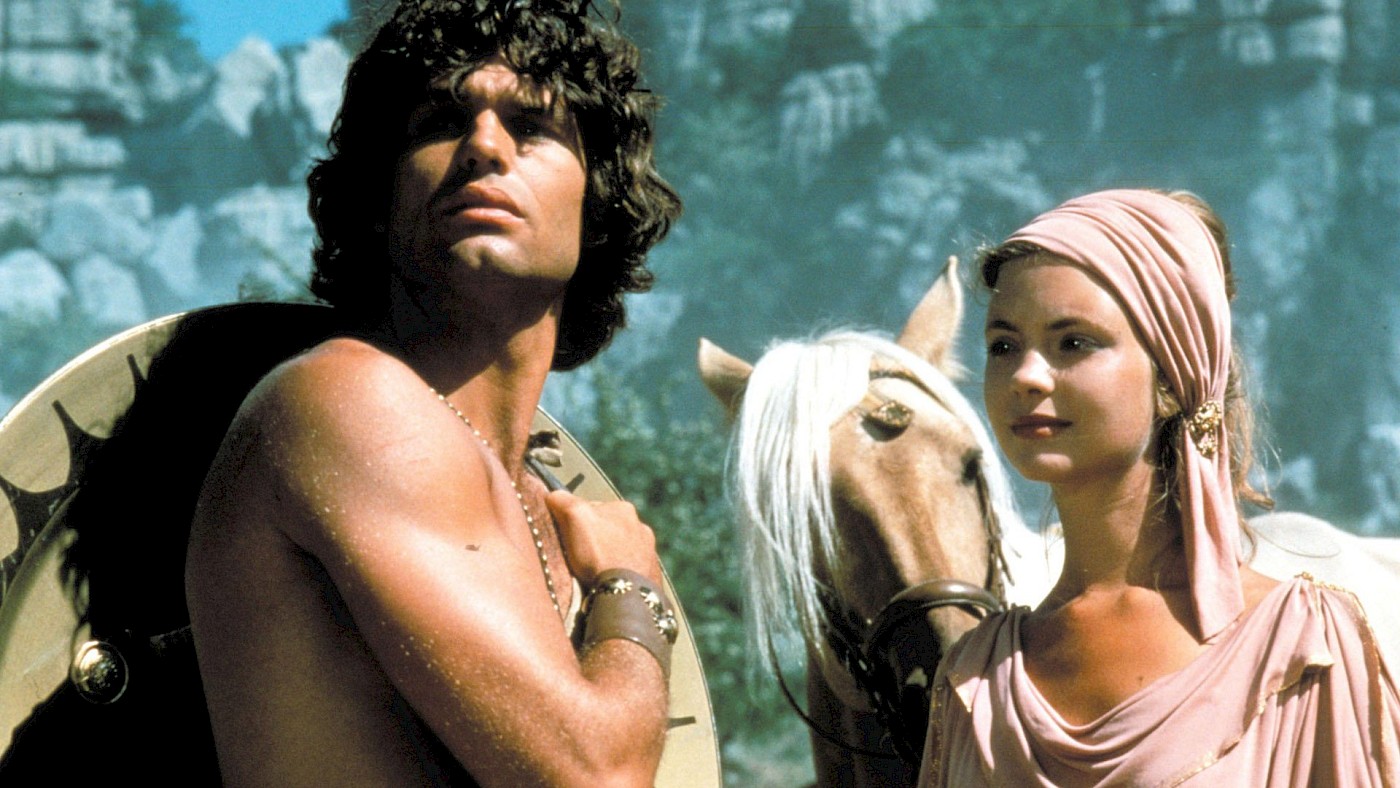The original Clash of the Titans was released in 1981. It was directed by Desmond Davis, though most people associate it more heavily with producer Ray Harryhausen, who created the creature effects for the movie. The story takes its cue from the Perseus myth, but also invents a bunch of needless stuff along the way.
The movie opens with Acrisius (Donald Houston) at the seaside, condemning Danaë and her infant son to a watery tomb by locking them inside a chest and throwing it into the sea. The close-ups of Acrisius took me out of the movie, since you can clearly see that most of his molars are fitted with modern, silver-coloured fillings. The fact that his fantastical helmet doesn’t fit well is also a little jarring. (I won’t comment much on the clothes and equipment in the movie: they’re standard Hollywood fare and have little to do with history.)

As the movie tracks the chest, bombastic movie starts and the title credits are shown, which shift at some point to helicopter shots of a landscape that is decidedly not Greece, with the black outline of a seagull superimposed awkwardly in some shots. Eventually, we reach Olympus – where, I think, seagulls have no reason to be. This seagull we’ve been following then turns into Poseidon (Jack Gwillim), who strolls across the floor, where the other gods have also gathered, towards Zeus (Laurence Olivier), seated on his throne.
Punishment of Argos
Poseidon explains that things have happened as they feared. Zeus decrees that Acrisius and the whole of Argos must be punished and orders Poseidon to “Let loose the Kraken”. This sea-monster is described as the “last of the Titans”, which is utter nonsense. The Titans were the generation of gods who ruled before the Olympians, and they were nearly all safely locked away in the underworld. But they had to explain the title somehow, and so the one Titan clashing is what we’re left with.
Hera (Claire Bloom) doesn’t understand why Zeus is so angry. Thetis (Maggie Smith) explains it to her: he loved Danaë. In the meantime, Zeus has strolled away to an area of the throne room filled with little clay figures representing what seems to be all of humanity, and picks up the clay version of Danaë. I’ve always liked the idea of the Olympian gods possessing little figures that represent humans that they could pick up and play with.

Some chintzy effects follow in which Poseidon lets the Kraken loose and Argos is destroyed. I’ve never understood why they referred to the sea-monster as the “Kraken”, since the latter is very much a creature of Norse medieval tradition, rather than Greek. The Greek word was ketos, often Latinized to cetus, and I think that would have worked, too.
Zeus crushes the clay figure of Acricius in his hand, killing the king, while the city of Argos is drowned by the floods caused by the sea-monster as it splashes around in the sea. Meanwhile, the chest bearing Danaë and Perseus arrives safely at the island of Seriphos. A montage shows Perseus growing up, with scenes of Zeus inaudibly mumbling something to the other gods oddly spliced in between.
Enter Calibos
It’s at this point that we’re introduced to Calibos (played by Neil McCarthy in close-ups), the son of Thetis invented specifically for this movie. Zeus says he cannot be forgiven for his crimes and transforms him into a horned creature with a reptilian tail, much to Thetis’ chagrin, since he was originally destined to marry Andromeda and rule Joppa.
Of course, I have no idea why they introduced Thetis, since she’s best known as the mother of Achilles and has no role to play in the Greek myth. But she’s introduced here as the main antagonist in the story, and promises that if her son can’t marry Andromeda, then no man will.

Thetis picks up the clay figure of Perseus and transports him from Seriphos to the amphitheatre of Joppa, where he meets Ammon (Burgess Meredith). Perseus (Harry Hamblin) begins telling his story, but Ammon says that everybody already knows the tale.
By this point, twenty minutes have passed and we still haven’t gotten into the main plot of the movie. Zeus orders that Perseus is given weapons and armour to help him out: a sharp sword, a shiny shield, and a helmet that turns the wearer invisible (as explained by Zeus in an annoyingly stupid reversal of the old adage, “show, don’t tell”). The movie then continues onwards at a glacial pace.
Perseus wanders around Joppa, which is presented as a clichéd “exotic” city, with acrobats, a colourful bazar, monkeys, and beautiful women. Upon seeing a man being burnt at the stake, he asks a guard for more exposition – because if there’s one thing this movie lacked, it’s people talking about the plot. He briefly explains that the city is cursed and whoever wants to marry Andromeda (Judi Bowker), the daughter of Queen Cassiopeia (Siân Phillips, who most will recognize as Livia from the infinitely more superior TV series I, Claudius), have to answer a riddle or be killed.

It turns out, Andromeda’s soul is taken by a vulture at night to the swamps in the east (which are infested by North-American alligators, apparently), where Calibos resides. Ammon takes him to a watering hole, where Perseus tames the winged horse Pegasus (which, if you remember the original myth, didn’t exist until it sprung out of Medusa’s neck following her decapitation by Perseus). As typical for this movie, the sequence seems to last forever.
The scene shifts to show that Andromeda’s soul visits Calibos, who gives her the riddle to pose would-be suitors. Perseus, invisible, has seen everything. Calibos, however, notices his footsteps and follows him. There’s a brief struggle and the flash of Perseus’ sword. The scene then cuts to Joppa, where Cassiopeia asks for suitors. Perseus appears and steps forward. He solves the riddle and then throws the cut-off hand of Calibos on the steps.
Calibos prays to Thetis for justice (or revenge?), and it is at this point, at the 53-minute mark, that we finally get to the movie’s main plot. At the wedding of Perseus and Andromeda, Thetis interrupts the proceedings: Andromeda must be sacrificed in 30 days to the Kraken, or else the monster will destroy the city.
Myth-bending movie-making
The plot of the movie turns the original myth on its head. It starts off with Perseus marrying Andromeda, and in that way incurring the wrath of a god. The sea-monster will be unleased and cannot be defeated by a mortal. Perseus is sent out to ask for advice from the Stygian witches (the Graeae), who tell him that only the severed head of Medusa can destroy the monster.

The remainder of the movie sees Perseus travel the world in order to fulfil his quest. This is where most of the movie’s visual effects can be found, including a battle against a two-headed dog or wolf creature inside the actual ruins of an ancient Doric temple (which certainly mustn’t have been ancient back when in the time that the movie is set!).
Already in 1981, the visual effects for this movie seemed old fashioned. Ray Harryhausen essentially refined the effects that he was famous for since before 1963s Jason and the Argonauts. Nevertheless, the battle against Medusa is a remarkable feat of technical wizardry, almost seamlessly blending stop-motion animation with live-action footage. Pay special attention to the lighting in this scene: that must have been difficult to pull off well, even if the Medusa puppet remains entirely unconvincing.

Unsurprisingly, Perseus manages to decapitate Medusa. There’s a brief scene where Calibos stabs the head and blood falls on the ground, creating scorpions for Perseus and his men to fight in another drawn-out scene that also ends with the death of Calibos. Perseus hastens back to Joppa, where Andromeda is chained to a rock, and is just in time to save her from the Kraken.
Closing thoughts
The acting in this movie can best be described as perfunctory. Harry Hamblin’s Perseus is boring, wooden, and slow (just like the movie!), and he tends to have difficulty changing the expression on his face.
Most of the other actors don’t fare much better. Siân Phillips, in the rare moments that she is on screen, seems to constantly wonder what she’s doing in the film whenever she doesn’t have any lines to deliver, and Laurence Olivier comes across as far too gentle to play Zeus.
The dialogue certainly doesn’t do the actors any favours, as it can be very feeble in places. For example, Ammon at one point claims that, “The sands of time are running like quicksilver.” Ouch.

Back when the movie first came out, Bubo, the mechanical owl, was criticized for being essentially an R2D2 rip-off, created to make the movie more appealing to fans of Star Wars (1977).
Bubo was created by Hephaestus on the order of Athena, who did not want to send her real owl to aid Perseus, despite Zeus’ orders. While the bird is annoying, it isn’t the worst thing in the movie, but can be regarded as yet another piece of filler; ballast to further slow down a movie that already crawls along at a turgid pace.
All in all, the movie is a slow and largely uninteresting mess that never really seems to take off in a convincing way. In rewriting the original story, they ended up with a plot so convoluted that it literally takes an hour to just set up what should have been the movie’s main focus: Perseus’ quest against the gorgon Medusa and his rescue of Andromeda.
